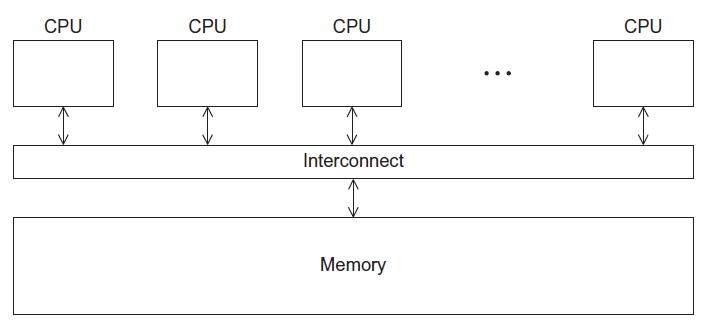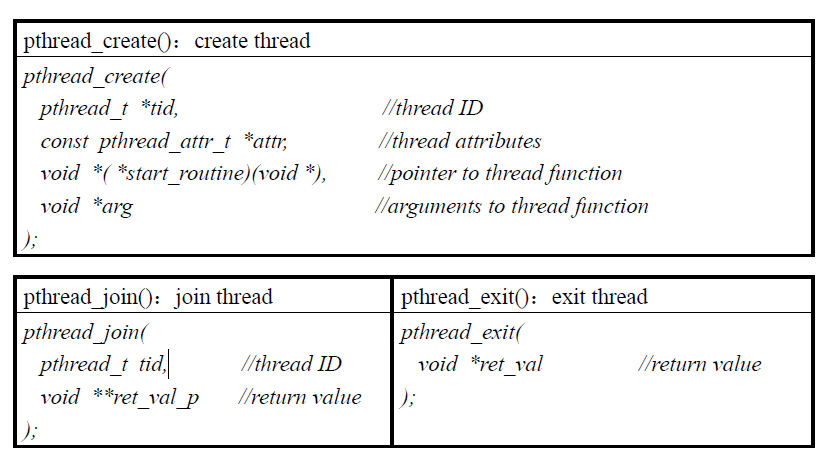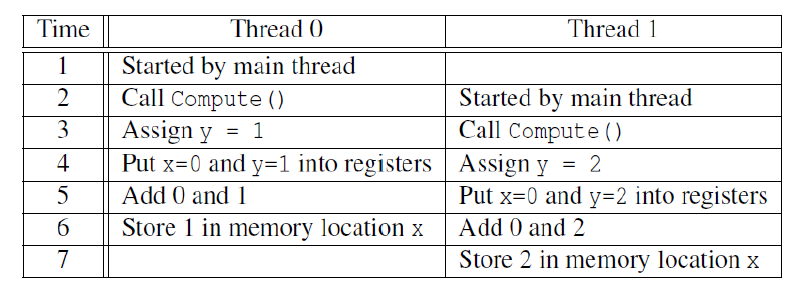并行计算-pthread
Pthread:共享内存系统并行编程模型

所有处理器能看到同样的内存地址空间
因为访问冲突会加重,一般最多32个核
线程:轻量级的进程,多个线程可以共享进程中的空间
基于c和c++,基于类unix系统(linux,windows)
每个线程都有一个在进程中唯一的线程标识符,用一个数据类型 pthread_t 表示,该数据类型在 Linux 中就是一个无符号长整型数据。
常用函数

线程的创建:pthread_create
pthread_create:创建一个线程,在其中执行对应的函数start_routine。线程需要提前利用pthread_t threads[NUM_THREADS];定义
1 | int pthread_create(pthread_t *thread, const pthread_attr_t *attr, void *(*start_routine)(void *), void *arg); |
功能说明:创建一个线程。
参数说明:
thread是线程标识符,但这个参数不是由用户指定的,而是由pthread_create函数在创建时将新的线程的标识符放到这个变量中。- 需要提前利用
pthread_t threads[NUM_THREADS];定义线程
- 需要提前利用
attr指定线程的属性,可以用 NULL 表示默认属性。start_routine是一个函数指针,指定在线程中运行的函数。arg是start_routine所需要的参数,是一个无类型指针。
默认地,线程在被创建时要被赋予一定的属性,这个属性存放在数据类型 pthread_attr_t 中,它包含了线程的调度策略,堆栈的相关信息,join or detach 的状态等。
pthread_attr_init 和 pthread_attr_destroy 函数分别用来创建和销毁 pthread_attr_t,具体函数声明可参考man帮助。
1 |
|
对线程的阻塞:pthread_join
pthread_join:函数原型:
1 | int pthread_join(pthread_t thread, void **status); |
pthread_join 作用是等待一个指定的线程结束执行,然后才继续执行当前线程。函数会让调用它的线程等待 threadid 线程运行结束之后再运行,可以对每个线程使用一次。
- 等待线程结束:当一个线程调用
pthread_join(thread, status)时,它会被阻塞,直到线程thread完成其执行。只有当线程thread终止后,pthread_join才会返回。 - 获取线程的退出状态:
pthread_join的第二个参数status是一个指向整数的指针,用于存储线程的退出状态。当线程thread结束时,它的退出状态会被写入到status指向的地址中,以便父线程可以查看线程的返回值或错误状态。
join的含义
在并行计算中,“join” 通常表示等待其他线程完成其工作,以便能够收集和整合它们的结果或执行后续操作。这在多线程或多进程的并行计算中非常常见,其中一个主线程(或进程)会创建和管理多个子线程(或子进程),并使用 pthread_join(或其他等待机制)等待它们完成任务。
例如,假设您有一个并行计算任务,将一个大数组分成多个部分,每个部分由一个线程处理。主线程可以创建这些线程,然后使用 pthread_join 等待它们完成处理。一旦所有线程都完成了它们的工作,主线程可以汇总它们的结果或执行其他操作。
有可能主线程完成了,但副线程还没完成,使用join进行等待。而且不只有 pthread_join 中的线程在运行,而是主调用线程(调用 pthread_join 的线程)会被阻塞,等待被指定的线程(作为参数传递给 pthread_join 的线程)运行完成后才会继续执行。被指定的线程仍然可以在后台执行,而主调用线程会被阻塞,直到指定线程完成其任务。
进程之间的交互
在多线程计算时,经常会有多个线程访问一些共享资源,因为彼此读取的不同步造成计算结果有无。
在多进程工作时,因为不同进程的处理时间有区别,对存储器的取值/赋值不一定是连续的,可能会丢失值
在计算时,如果使用不同进程计算不同部分,在总进程数增加时,精度越来越低。一个示例:sum+=i

注意:把调节读存的控制全局变量的影响调节到最小。有时候无法预估线程的时序先后,取决于OS的调度
互斥锁 Mutex
Mutex 常常被用来保护那些可以被多个线程访问的共享资源,比如可以防止多个线程同时更新同一个数据时出现混乱。
使用互斥锁的一般步骤是:
- 创建一个互斥锁,即声明一个
pthread_mutex_t类型的数据,然后初始化,只有初始化之后才能使用; - 多个线程尝试锁定这个互斥锁;
- 锁定互斥锁的线程才能够运行,否则不能运行
- 只有一个成功锁定互斥锁,成为互斥锁的拥有者,然后进行一些指令;
- 拥有者解锁互斥锁;
- 其他线程尝试锁定这个互斥锁,重复上面的过程;
- 最后互斥锁被显式地调用
pthread_mutex_destroy来进行销毁。
有两种方式初始化一个互斥锁:
第一种,利用已经定义的常量初始化,例如
1 | pthread_mutex_t mymutex = PTHREAD_MUTEX_INITIALIZER; |
第二种方式是调用 pthread_mutex_init (mutex,attr) 进行初始化。
当多个线程同时去锁定同一个互斥锁时,对于失败的那些线程:
- 如果是用
pthread_mutex_lock函数,那么会被阻塞,直到这个互斥锁被解锁,它们再继续竞争; - 如果是用
pthread_mutex_trylock函数,那么失败者只会返回一个错误。
1 |
|
常用函数
1 | pthread_mutex_init (mutex,attr); |
pthread_mutex_init(mutex, attr);- 作用:用于初始化一个互斥锁。
- 参数:
mutex:要初始化的互斥锁对象的指针。attr:互斥锁的属性,通常可以传递NULL来使用默认属性。
- 示例:
pthread_mutex_init(&mutex, NULL);
pthread_mutex_destroy(pthread_mutex_t *mutex);- 作用:用于销毁一个互斥锁,释放与之关联的资源。
- 参数:
mutex:要销毁的互斥锁对象的指针。 - 示例:
pthread_mutex_destroy(&mutex);
pthread_mutexattr_init(pthread_mutexattr_t *attr);- 作用:用于初始化一个互斥锁属性对象,以便设置互斥锁的属性。
- 参数:
attr:要初始化的互斥锁属性对象的指针。 - 示例:
pthread_mutexattr_init(&attr);
pthread_mutexattr_destroy(pthread_mutexattr_t *attr);- 作用:用于销毁一个互斥锁属性对象,释放与之关联的资源。
- 参数:
attr:要销毁的互斥锁属性对象的指针。 - 示例:
pthread_mutexattr_destroy(&attr);
pthread_mutex_lock(pthread_mutex_t *mutex);- 作用:用于锁定(获取)一个互斥锁,阻止其他线程进入临界区直到锁被释放。
- 参数:
mutex:要锁定的互斥锁对象的指针。 - 示例:
pthread_mutex_lock(&mutex);
pthread_mutex_trylock(pthread_mutex_t *mutex);- 作用:尝试锁定一个互斥锁,但如果锁已经被其他线程占用,则不会阻塞当前线程,而是立即返回一个错误代码。
- 参数:
mutex:要尝试锁定的互斥锁对象的指针。 - 返回值:成功锁定返回0,否则返回错误代码。
- 示例:
int result = pthread_mutex_trylock(&mutex);
pthread_mutex_unlock(pthread_mutex_t *mutex);- 作用:用于解锁(释放)一个互斥锁,允许其他线程进入临界区。
- 参数:
mutex:要解锁的互斥锁对象的指针。 - 示例:
pthread_mutex_unlock(&mutex);
条件变量 Condition Variable
互斥锁只有两种状态,这限制了它的用途。条件变量允许线程在阻塞的时候等待另一个线程发送的信号,当收到信号后,阻塞的线程就被唤醒并试图锁定与之相关的互斥锁。条件变量要和互斥锁结合使用。
- 一个线程首先获得互斥锁,获得对共享资源的访问权,同时对mutex上锁
- 在上锁后,由于默写条件,使用条件变量,让此线程沉睡,暂时释放互斥锁,由别的线程获得对共享资源的访问权
- 在到达条件变量的条件时,解锁互斥锁,发送信号到沉睡线程处,重新获得互斥锁,此时别的线程没有互斥锁
- 原先沉睡的线程继续运行
条件变量的声明和初始化
通过声明 pthread_cond_t 类型的数据,并且必须先初始化才能使用。
初始化的方法也有两种:
第一种,利用内部定义的常量,例如:
1 | pthread_cond_t myconvar = PTHREAD_COND_INITIALIZER; |
第二种,利用函数 pthread_cond_init(cond,attr),其中 attr 由 pthread_condattr_init() 和 pthread_condattr_destroy() 创建和销毁。
可以用 pthread_cond_destroy() 销毁一个条件变量。
相关函数:
1 | pthread_cond_wait (condition,mutex); |
pthread_cond_wait() 会阻塞调用它的线程,直到收到某一信号。这个函数需要在 mutex 已经被锁之后进行调用,并且当线程被阻塞时,会自动解锁 mutex。信号收到后,线程被唤醒,这时 mutex 又会被这个线程锁定。
pthread_cond_signal() 函数结束时,必须解锁 mutex,以供 pthread_cond_wait() 锁定mutex。
当不止一个线程在等待信号时,要用 pthread_cond_broadcast()代替 pthread_cond_signal() 来告诉所有被该条件变量阻塞的线程结束阻塞状态。
1 |
|
线程的性质:结合与分离
在任何一个时间点上,线程是可结合的(joinable),或者是分离的(detached)。
-
一个可结合的线程能够被其他线程收回其资源和杀死;在被其他线程回收之前,它的存储器资源(如栈)是不释放的。
-
相反,一个分离的线程是不能被其他线程回收或杀死的,它的存储器资源在它终止时由系统自动释放。
线程的分离状态决定一个线程以什么样的方式来终止自己。
-
在默认情况下线程是非分离状态的,这种情况下,原有的线程等待创建的线程结束。只有当
pthread_join()函数返回时,创建的线程才算终止,才能释放自己占用的系统资源。 -
而分离线程不是这样子的,它没有被其他的线程所等待,自己运行结束了,线程也就终止了,马上释放系统资源。
- 如果在创建线程时就知道不需要了解线程的终止状态,则可以
pthread_attr_t结构中的detachstate线程属性,让线程以分离状态启动。
设置线程分离状态的函数为:
- 如果在创建线程时就知道不需要了解线程的终止状态,则可以
1 | // 第二个参数可选为: |
这里要注意的一点是,如果设置一个线程为分离线程,而这个线程运行又非常快,它很可能在pthread_create函数返回之前就终止了,它终止以后就可能将线程号和系统资源移交给其他的线程使用,这样调用pthread_create的线程就得到了错误的线程号。
要避免这种情况可以采取一定的同步措施,最简单的方法之一是可以在被创建的线程里调用pthread_cond_timewait函数,让这个线程等待一会儿,留出足够的时间让函数pthread_create返回。设置一段等待时间,是在多线程编程里常用的方法。但是注意不要使用诸如wait()之类的函数,它们是使整个进程睡眠,并不能解决线程同步的问题。
另外一个可能常用的属性是线程的优先级,它存放在结构sched_param中。用函数pthread_attr_getschedparam和函数pthread_attr_setschedparam进行存放,一般说来,我们总是先取优先级,对取得的值修改后再存放回去。
线程等待——正确处理线程终止
1 |
|
如果线程处于joinable状态,则只能只能被创建他的线程等待终止。
在Linux平台默认情况下,虽然各个线程之间是相互独立的,一个线程的终止不会去通知或影响其他的线程。但是已经终止的线程的资源并不会随着线程的终止而得到释放,需要调用 pthread_join() 来**获得另一个线程的终止状态并且释放该线程所占的资源。**在thread_join中存储了返回状态。
调用该函数的线程将挂起,等待 th 所表示的线程的结束。 thread_return 是指向线程 th 返回值的指针。并且只可以有唯一的一个线程对 th 调用 pthread_join() 。
需要注意的是 th 所表示的线程必须是 joinable 的,即处于非 detached(游离)状态;
如果 th 处于 detached 状态,那么对 th 的
pthread_join()调用将返回错误。
如果不关心一个线程的结束状态,那么也可以将一个线程设置为 detached 状态,从而让操作系统在该线程结束时来回收它所占的资源。将一个线程设置为detached 状态可以通过两种方式来实现。
- 一种是调用
pthread_detach()函数,可以将线程 th 设置为 detached 状态。 - 另一种方法是在创建线程时就将它设置为 detached 状态,首先初始化一个线程属性变量,然后将其设置为 detached 状态,最后将它作为参数传入线程创建函数
pthread_create(),这样所创建出来的线程就直接处于 detached 状态。
创建 detach 线程:
1 | pthread_t tid; |
总之为了在使用 pthread 时避免线程的资源在线程结束时不能得到正确释放,从而避免产生潜在的内存泄漏问题,在对待线程结束时,要确保该线程处于 detached 状态,否着就需要调用 pthread_join() 函数来对其进行资源回收。

